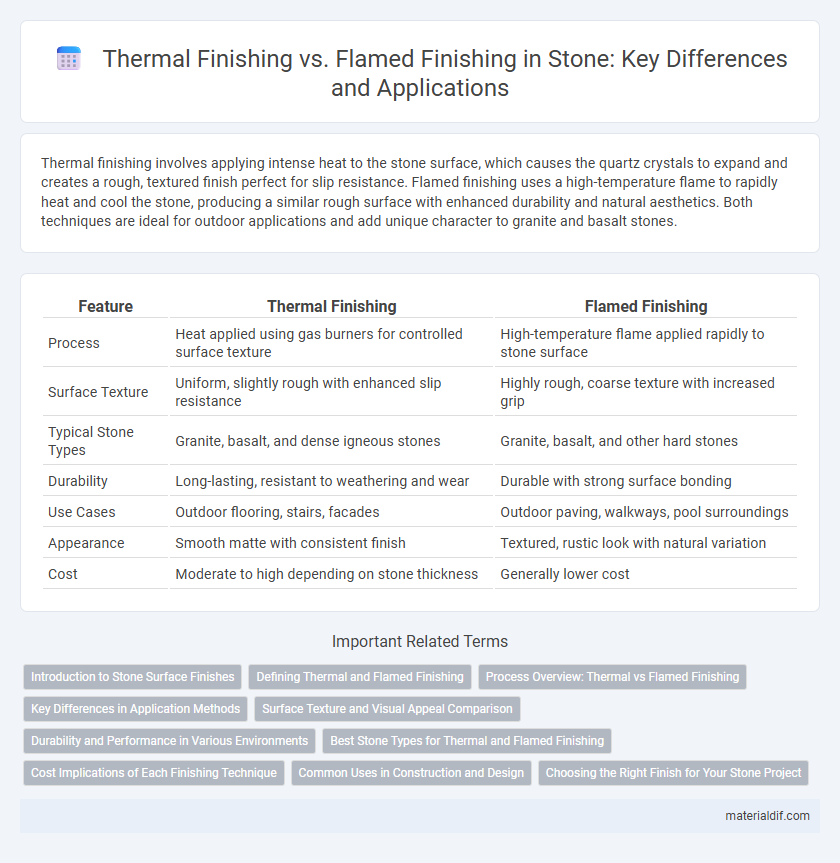Thermal finishing involves applying intense heat to the stone surface, which causes the quartz crystals to expand and creates a rough, textured finish perfect for slip resistance. Flamed finishing uses a high-temperature flame to rapidly heat and cool the stone, producing a similar rough surface with enhanced durability and natural aesthetics. Both techniques are ideal for outdoor applications and add unique character to granite and basalt stones.
Table of Comparison
| Feature | Thermal Finishing | Flamed Finishing |
|---|---|---|
| Process | Heat applied using gas burners for controlled surface texture | High-temperature flame applied rapidly to stone surface |
| Surface Texture | Uniform, slightly rough with enhanced slip resistance | Highly rough, coarse texture with increased grip |
| Typical Stone Types | Granite, basalt, and dense igneous stones | Granite, basalt, and other hard stones |
| Durability | Long-lasting, resistant to weathering and wear | Durable with strong surface bonding |
| Use Cases | Outdoor flooring, stairs, facades | Outdoor paving, walkways, pool surroundings |
| Appearance | Smooth matte with consistent finish | Textured, rustic look with natural variation |
| Cost | Moderate to high depending on stone thickness | Generally lower cost |
Introduction to Stone Surface Finishes
Thermal finishing involves exposing stone surfaces to high-temperature flames, causing mineral grains to burst and create a textured, slip-resistant finish ideal for outdoor applications. Flamed finishing uses rapid heating followed by immediate cooling to produce a rough, natural-looking surface that enhances stone's durability and aesthetic appeal. Both techniques modify the stone's surface properties, optimizing it for safety and architectural design.
Defining Thermal and Flamed Finishing
Thermal finishing involves applying intense heat to the stone surface, causing minor melting and fusing of the minerals, resulting in a textured, slip-resistant finish. Flamed finishing specifically uses a high-temperature flame to rapidly heat the stone, leading to surface explosion and roughening, ideal for granite and other dense stones. Both techniques enhance durability and aesthetic appeal but differ mainly in the heat application method and resulting texture.
Process Overview: Thermal vs Flamed Finishing
Thermal finishing involves exposing the stone surface to intense heat using a high-temperature flame, causing the surface to burst and create a rough texture ideal for slip resistance. Flamed finishing specifically uses a direct flame torch to rapidly heat and cool the stone, resulting in a pronounced, rugged texture that enhances natural stone aesthetics. Both methods leverage thermal shock to alter the stone's surface, but flamed finishing applies a more concentrated flame, producing a deeper, more textured finish compared to thermal finishing's broader heat application.
Key Differences in Application Methods
Thermal finishing involves applying intense heat with a high-temperature flame to the stone surface, causing the minerals to expand and create a textured, non-slip finish. Flamed finishing specifically uses a direct flame to rapidly heat and cool the stone, resulting in a rough, natural appearance ideal for outdoor applications. The key difference lies in thermal finishing's controlled heat application for uniform texture versus flamed finishing's abrupt flame exposure, producing a more rugged surface.
Surface Texture and Visual Appeal Comparison
Thermal finishing creates a rough, textured surface by rapidly heating stone and cooling it, enhancing slip resistance and giving a natural, rustic appearance ideal for outdoor use. Flamed finishing involves blasting stone with high-temperature flames, producing a coarse, raised texture that maintains the stone's original color while adding a visually striking, rugged look. Both methods improve durability, but thermal finishing typically offers a softer texture, while flamed finishing delivers a more pronounced and dramatic surface effect.
Durability and Performance in Various Environments
Thermal finishing involves exposing stone surfaces to intense heat, causing rapid cooling that enhances durability by creating a rough, slip-resistant texture, ideal for outdoor and wet environments. Flamed finishing uses a high-temperature flame to expand the stone's surface, improving resistance to wear and weathering while maintaining natural aesthetics suitable for pathways and facades. Both methods increase stone performance in diverse climates, with thermal finishing offering superior slip resistance and flamed finishing providing balanced durability and visual appeal.
Best Stone Types for Thermal and Flamed Finishing
Granite and quartzite are the best stone types for thermal finishing due to their high heat resistance and durability, which enhances their natural texture and slip resistance. Flamed finishing is ideal for granite and basalt, as the intense heat treatment creates a rough, non-slip surface perfect for outdoor applications. Marble and limestone generally do not withstand the extreme heat required for thermal or flamed finishes, making them less suitable for these techniques.
Cost Implications of Each Finishing Technique
Thermal finishing of stone involves high heat application, leading to a higher energy cost compared to flamed finishing, which uses direct flame to quickly roughen the surface with lower energy consumption. Flamed finishing tends to be more cost-effective due to reduced labor time and material wastage, making it preferred for large-scale projects requiring textured surfaces. While thermal finishing provides more uniform results ideal for premium applications, the elevated operational expenses often outweigh its benefits in budget-sensitive environments.
Common Uses in Construction and Design
Thermal finishing is commonly used for granite countertops and exterior cladding, providing a slip-resistant surface ideal for outdoor applications. Flamed finishing is preferred for paving stones and stair treads, enhancing texture and durability while maintaining a natural stone appearance. Both techniques improve surface grip and aesthetic appeal, but thermal finishing offers a more uniform texture suitable for high-traffic areas.
Choosing the Right Finish for Your Stone Project
Thermal finishing and flamed finishing both enhance stone surfaces by applying intense heat, but thermal finishing produces a more uniform texture while flamed finishing creates a rougher, textured appearance ideal for slip resistance. Selecting the right finish depends on the intended use; thermal finishing suits both interior and exterior projects requiring subtle texture, whereas flamed finishing is preferred for outdoor applications where durability and traction are critical. Consider the stone type and project environment to ensure optimal aesthetic appeal and functional performance.
Thermal Finishing vs Flamed Finishing Infographic

 materialdif.com
materialdif.com